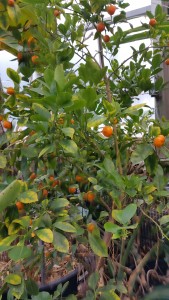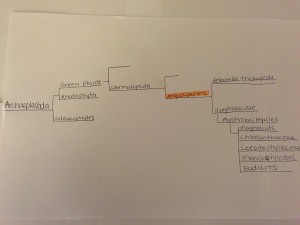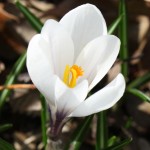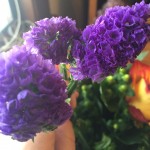Lifecycle & Ecology
https://www.youtube.com/watch?v=j6LCCxFeDq8&feature=youtube_gdata
The Angiosperm Life Cycle Video – This is a look at the growth, fertilization, and pollination events in flowering plants. The diversity of morphology in angiosperm structures helps to facilitate this life cycle. It is the reason that angiosperms have been able to be ubiquitous throughout the various biomes of our Earth! Created by Emily Thomas.
Angiosperms are considered to be one of the greatest examples of symbionts in nature, due to their many mutualistic relationships with pollinators, fungi, herbivores and others. They can be found in almost any environment, so long as there is sunlight, some form of water, and a way to spread their offspring. The general life cycle of angiosperms is explained in the video on this page, ‘Angiosperm Life Cycle.’ While this video focuses on a more general view, the four major events that make up flowering plant reproduction (pollen development, egg development, pollination and fertilization) will be focused on in more detail here. Angiosperms produce two types of spores; microspores which lead to the generation of pollen and megaspores which form the structure that houses female gametophytes (Boundless, 2014).
Pollen develops inside the stamen. Inside the anther of an angiosperm lie the diploid microspores. These microspores undergo meiosis to become haploid microspores. Haploid microspores then undergo mitosis to develop into pollen grains. Pollen forms from the male gametophyte in flowering plants. The gametophyte consists of two cell types: tube cells to aid in fertilization and generative cells which generate sperm cells (Taiz, 2006).
Egg development occurs inside the carpel. Inside of the ovaries are egg producing structures known as ovules. Inside of an ovule are diploid cells. Similar to the production of pollen, these diploid cells divide via meiosis to become haploid cells that are the megaspores. These spores then go through three rounds of mitosis forming seven cells. One of the cells has two nuclei, called the endosperm and another of the cells becomes the egg. The remaining five cells are not used in reproduction (Boundless, 2014).
Once both eggs and pollen development have taken place they are ready for pollination. Pollination can occur in many ways; two major forms are wind and water dispersal. Unique to angiosperms is the use of pollinators such as birds and bees. The last step in flowering plant reproduction is fertilization. For fertilization to occur the tube cell of the male gametophyte creates a tube to the ovule (Taiz, 2006). The generative cell uses this tube to send sperm down to the ovule so fertilization can occur. One sperm will fuse with the egg forming a zygote the other fuses with the endosperm forming a triploid endosperm cell. This process, known as double fertilization, is unique to angiosperms (Derksen, 2013). The endosperm later develops into nutrient tissue while the zygote divides by mitosis, developing into an embryo which grows into a mature plant.
Angiosperms spend most of there life in the adult stage known as a sporophyte. When we see trees, grass, flowers, vegetables in a garden we are seeing sporophytes! Angiosperms are very important due to their abundance and impact on almost every habitat on earth. Due to their diverse morphology they can range from the small to massive, aquatic to mountainous, grass to trees and everything in between.
Evolutionary History

The Amorphophallus titanum, or Corpse flower is one of the oldest and most bizarre ancestors of modern angiosperms. Photo by Nick White.
Not surprisingly, angiosperms are the most commonly found type of land plant. Angiosperms evolved in the Cretaceous era, around the same time as many groups of modern insects. Many of these insects acted as pollinators that drove the evolution of both angiosperms and the insects themselves. (Soltis 2005). Due to the availability of pollinators (insects occupy nearly every environment on the planet) it has allowed angiosperms to become the most numerous plant found on land. This relationship is considered one of the greatest examples of symbioses in nature due to their many mutualistic relationship with pollinators, fungi, herbivores and others. They can be found in almost any environment, so long as there is sunlight, some form of water, and a way to spread their offspring.With co-evolution, these two species have been able to occupy places that few other species previously could, changing the habitats of the entire planet.(Lerner 2008)
Unlike many land plants, angiosperms did not evolve from gymnosperms. It is unclear what type of plants gave rise to angiosperms. (Angiosperms 2014) Some scientists believe that a group of plants known as “seed ferns” ,or pteridosperms, may have been the progenitor of the angiosperms. These “seed ferns” were around for many millions of years before angiosperms and yet have similar traits like seed-bearing capsules and specialized organs that produced pollen. While we are still not exactly sure how ancient angiosperms may have come about, we have an idea of what these ancestors may have looked like. They were likely small with small flowers. The flowers were probably green and not at all like the flowers we are used to as their sepals and petals would not be separated or distinguishable (Angiosperms 2014). And while the exact way that angiosperms evolved to what we know today is still unclear, their impact on our world today is obvious.
A Survey of Extant Diversity
Angiosperms are arguably the largest extant group of plants on the planet today. At least 260,000 living species exist, which are classified into 453 families (Soltis 2005). The most popular

The photo above are barrel cacti (Echinocactus grusonii) displaying the numerous spines that are used for protection. Additionally, these cacti have modified leaves, which help retain water in dry environments; they are also known as succulents. Photo by Nick White.
lineage would be the eudicots, which includes most flowering plants. Some other major lineages are the Monocotyledons, containing families like lilies, grasses, and orchids, and the Nymphaeaceae, which hold the water lilies and their relatives (Soltis 2005). Angiosperms inhabit all seven continents, as well as the oceans. They are able to occupy just about any environment on earth, for example, high mountaintops, deep oceans, freezing tundras, and of course, warm, wet rainforests. Their abundance in these environments is immense. They have an extremely large genome, which may explain their ability to exist in so many different morphological forms. Some examples of these forms include grasses, climbing vines, large trees, and small flowers. By diversifying their physiology, angiosperms have been able to adapt to the variety of ecosystems which cover the earth. The cactus, for example, has modified leaves, called spines, which help to prevent it’s desiccation in dry, arid deserts (see photo below). Some types of angiosperms can be quite special and complex in terms of their nutrient acquisition, for example, carnivorous flowers, or poisonous vines.
Angiosperms provide an enormous environmental and economical importance. Environmentally, they use the carbon dioxide we produce, and turn it into the oxygen that is pertinent to our survival. Obviously, they also provide food for a variety of organisms, including humans. All of the fruits and vegetables bought in our grocery stores are products of angiosperms. Many insects also feed on these plants leaves, and bees use them to create their honey. Trees provide shelter and places to build homes for countless organisms, such as birds and squirrels, while we use the wood to build our houses, and make our paper. In fact, the clothes we wear everyday come from cotton plants, which are angiosperms. Certain angiosperms are also used as a source to create medicines. A common medicine, morphine, is made from the opium poppy (Papaver somniferum), and is used everyday in hospitals for pain relief (Taylor 1996). Another drug called cynarin comes from a chemical in the common artichoke (Cynara scolymus). It is being used in Germany to treat liver problems and hypertension (Taylor 1996). As you might have guessed, the abundance of angiosperms is crucial for human existence, as well as the majority of other organisms on earth, and it would be impossible to name every use and importance of these plants.
Conclusion
Researchers are working to clarify the emergence of angiosperms and delineate their origins to compensate for discrepancies between the fossil and molecular clock data (Peppe, 2013). Like many fossil records, the angiosperm fossil record is believed to lag behind the time of divergence for the clade. Peppe explains that the only way to resolve the issues between the fossil record, which suggests the arrival of angiosperms in the early Cretaceous period, and molecular dating, which suggests arrival in the Jurassic, is to look for Triassic and Jurassic fossils “with an eye toward finding angiosperm and angiosperm-like plant fossils” (2013).
One such study, the Hochuli and Feist-Burkardt (2013), examined fossilized pollen samples to try to identify early angiosperms and potential features which can be used to firmly identify the clade. The research identified the pollen as “Triassic and Jurassic angiosperm-like fossils,” which, while not angiosperms themselves, could be useful in establishing ancestral features and pinpointing groups which were evolving traits useful in characterizing modern angiosperms. By finding these earlier emerging pre-angiosperm groups within the fossil records, scientists can develop better hypotheses about when and where the earliest angiosperm fossils may be found (Peppe, 2013).
Other areas of ongoing research are expansive. The worldwide prominence of angiosperms has led to curiosity surrounding their reproduction, diversity, speciation, and uses. The diversity and accessibility of angiosperms means that funding availability tends to be the determining factor in driving research. As a result, much research focuses on the medicinal and agricultural uses of the flowering plants, because of the implications for humans (Reddy and Yang, 2011). Angiosperms include everything from corn to oak trees, so research focuses on effective crop cultivation, pesticide use, sustainability, and industrial uses. One of the most interesting research topics in agriculture surrounds the introduction of genetically modified organisms (GMOs) to the market (Miraglia, et. al, 2004).
From an ecological perspective, angiosperms reproduction via pollination and their intrinsic link to their pollinators has driven many research projects on the coevolution of plants and animals. The wide range of shape, size, color, and chemical secretions of the plants’ flowering portions, as well as the fast morphological differences in their fruiting body, have led to morphological specificity and behavioral patterning amongst insects, birds, and some mammals (Jarzden and Dilcher, 2010).
Additional Resources
The angiosperm group is a diverse one. Flowering plants, which make up so much of what we see, eat, and use every day, are a source of fascination. These plants have adapted to inhabit nearly every corner of land on the Earth. Curiosity surrounding the variation, morphology, evolution, and prevalence of angiosperms, has led to the establishment of many resources for those looking to further their understanding. The following are just some of the many videos and articles available for continued learning about these magnificent plants.
Angiosperm In Encyclopædia Britannica (http://www.britannica.com/EBchecked/topic/24667/angiosperm) is a very comprehensive encyclopedia entry that covers everything from general features, to reproduction, to classification, and fossilization. The entry is broken into subsections so that readers can focus on their areas of interest or questions. There are even quizzes to check understanding,
Biology for Kids (http://www.biology4kids.com/files/plants_angiosperm.html) provides a shorter, basic introduction to angiosperms as a whole in a language that is accessible to explorers of all ages. The page also provides resources for further learning.
‘Sexual Reproduction in Flowering Plants’ and ‘Flowers: Sexual Reproduction in Flowering Plants,’ which can be found on YouTube at https://www.youtube.com/watch?v=w1BSCJrH4lU and https://www.youtube.com/watch?v=hf9XlqXcal0 , help to explain the reproductive parts of a flower and the mechanisms surrounding pollination, fertilization, and fruit development. Both videos are about 2 and a half minutes long and appropriate for an audience with a basic understanding of plants.
The Pollinator Partnership website (http://www.pollinator.org/) is a great resource for those curious about learning more about the organisms which serve as pollen carriers for angiosperms. It not only provides basic information and further resources, but also explains the ecological importance of pollinators and how we can protect the creatures which help us sustain our agriculture and industry.
Flowering Plants: Keys to Earth’s Evolution and Human Well-Being is a 2005 Q&A interview with Pamela Soltis Ph.D, a key contributor to the Tree of Life. Soltis describes, in an easy and engaging way, the value of angiosperms in terms of their diversity, uses, and everyday influence on humans. It answers a lot of the “why should we care?” questions and explains the intertwined relationship of animal and plant. The full transcript can be found at http://www.actionbioscience.org/genomics/soltis.html.
Works Cited
Angiosperms. (2008). In L. Lerner & B. Lerner (Eds.), The Gale Encyclopedia of Science (4th ed., Vol. 1, p. 217). Detroit: Gale.Carter, J. (2014, January 17). Angiosperms. Retrieved March 6, 2015, from http://biology.clc.uc.edu/courses/bio106/angio.htm
Boundless. “Evolution of Angiosperms.” Boundless Biology. Boundless, 14 Nov. 2014. Retrieved 29 Mar. 2015 from https://www.boundless.com/biology/textbooks/bound20-11841/
Carter, J. Stein. (2014, Jan. 17) Angiosperms. Retrieved from http://biology.clc.uc.edu/courses/bio106/angio.htm.
Derksen, J., & Pierson, E. (2013, September 10). Life cycles. Retrieved March 30, 2015 from http://www.vcbio.science.ru.nl/en/virtuallessons/pollenreproduction/.
Dilcher, D. (2000). Toward a new synthesis: Major evolutionary trends in the angiosperm fossil record. Proceedings of the National Academy of Sciences, 7030-7036. http://dx.doi.org/10.1073/pnas.97.13.7030
Hedges, S., & Kumar, S. (2009). Plants. In The Timetree of Life (pp. 133-137, 162-165). Oxford: Oxford University Press.
Jarzen, David M. and Dilcher, David L. (2010). Coevolution between flowering plants and insect pollinators. In AccessScience. McGraw-Hill Education. Retrieved from http://accessscience.com/content/coevolution-between-flowering-plants-and-insect-pollinators/YB100138
Miraglia, M., Berdal, K. G., Brera, C., Corbisier, P., Holst-Jensen, A., Kok, E. J., & Zagon, J. (2004). Detection and traceability of genetically modified organisms in the food production chain. Food and Chemical Toxicology, 42(7), 1157-1180. http://dx.doi.org/10.1016/j.fct.2004.02.018
Peppe, D. (2013, October 15). What do we know about the origin of flowering plants? Retrieved March 30, 2015, from http://blogs.egu.eu/network/palaeoblog/2013/10/15/what-do-we-know-about-the-origin-of-flowering-plants/
Reddy, N., & Yang, Y. (2011). Potential of plant proteins for medical applications. Trends in biotechnology, 29(10), 490-498. http://dx.doi.org/10.1016/j.tibtech.2011.05.003
Soltis, D., Soltis, P., & Edwards, C. (2005, June 3). Angiosperms: Flowering Plants. Retrieved March 6, 2015, from http://tolweb.org/Angiosperms/20646/2005.06.03
Taylor, Leslie. (1996) Plant-Based Drugs and Medicines. Retrieved March 29, 2015, from http://www.rain-tree.com/plantdrugs.htm#.VRh1E4tAxgs.
Taiz, L., & Zeiger, E. (2006) Topic 1.3. Retrieved March 30, 2015, from http://5e.plantphys.net/article.php?id=474














